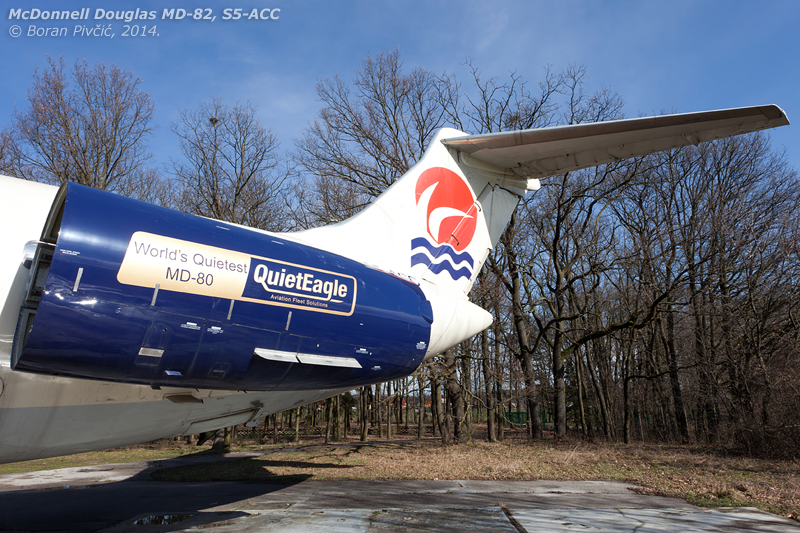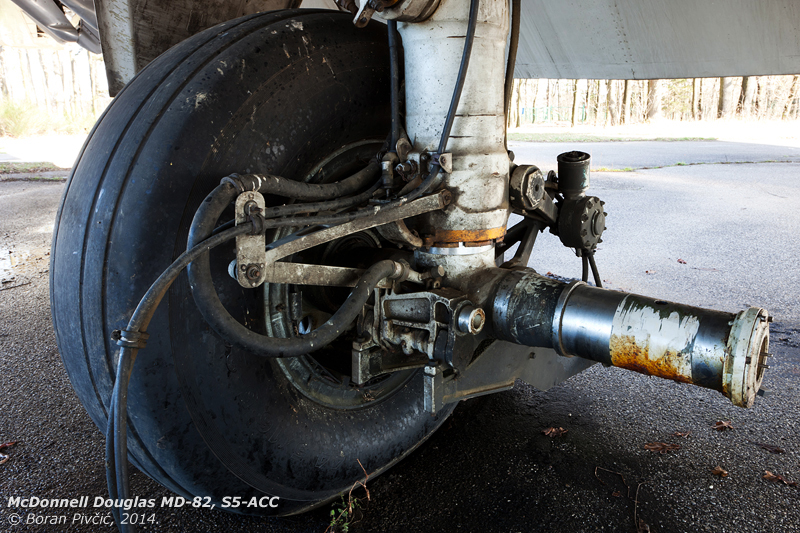By me
All photos me too, copyrighted
While I have stated on more than one occasion that I’m not much of an airliner person, I’m nevertheless always on the lookout for rare and interesting examples of the breed – especially if they have a fair bit of history (and the odd plot twist) behind them 🙂 . Unfortunately though, the region’s traditionally fickle airline fortunes mean that “rare and interesting” is often synonymous with “abandoned and failed”, with a number of local airports home to disused aircraft in various states of (dis)repair that had been left behind when their parent companies went under. The very nature of these airlines – small, private start-ups fighting uphill for their place under the sun – had meant that these machines would inevitably be cheap members of the MD-80 family, with three such frames located within a 200 km radius from Zagreb.
One of these (and by far the best preserved) is the titular MD-82, nowadays displayed at Maribor Airport (LJMB) and briefly featured in one of my previous posts – where I’d pledged to give it a proper “work over” at some later date 🙂 . So, for another of my periodic returns to the world of commercial aviation, I’ve decided to make good on that pledge and – catching a break in our depressing winter weather – drove up there to see what’s what…

Mad Dog One
Following the universal path of the MD-80, ACC had led quite a varied and geographically diverse life, latterly changing operators more often than most people do socks 😀 . Sporting the serial 48095 and line number 1055, its story begins with first flight on 20 January 1982, soon after which – 23 April to be precise – it would join the fleet of Pacific Southwest Airlines (PSA) as N940PS. Interestingly – though I’ve been told this was not unusual among early Mad Dogs – N940PS had actually started out in life as an MD-81, to be reworked into its current MD-82 standard sometimes in the mid 80s. While both versions are visually identical inside and out, the 82 is fitted with more powerful Pratt & Whitney JT8D-217A engines – which produce 89 kN of thrust, versus the 82 kN of the -209 series fitted to the 81 – allowing for greatly improved performance in hot and high* conditions. The extra grunt had also led to a Maximum Take Off Mass (MTOM) increase of around three tons, even though fuel, passenger and cargo capacities had remained the same.
* a term that has pretty much entered everyday aviation conversation, “hot and high” refers to a specific set of atmospheric conditions created by a combination of high temperature and altitude. As the air warms up, its density begins to decrease, leading (among other things) to a reduction in engine efficiency and power. The same effect also occurs as altitude increases and is essentially one of the major factors that define an aircraft’s performance ceiling. Individually, either of these effects can be handled and overcome without undue problems by the majority of “regular” aircraft; however, when they combine, their total impact can be such that operations are only possible at very low weights – weights that imply a small payload and questionable operating economics. To overcome these conditions (found in many lucrative coastal areas around the world), several aircraft have been designed with higher than usual power-to-weight ratios and aerodynamics tailored to get as much out of thin air as possible. By far the most famous of these is the superlative 757, which, on a cold day at low altitude, can leave any other airliner for dead in the take off and climb 🙂 .
N940PS itself would continue to fly with PSA all the way into the beginning of April 1988, when the company merged with rival USAir (precursor to today’s US Airways). Retained in the new combined fleet, the aircraft would become N815US on 9 April, and would continue to serve staunchly until it left the fleet for good on 27 February 1997.
From there on end though, things start to get interesting 😀 . As far as the Internet is concerned, the aircraft had disappeared off the face of the planet for several years – in all probability spending some time in a desert somewhere – until it resurfaced back again in May 2003 as 9A-CBD 🙂 . Operated by Air Adriatic – one of the very few private airlines to have ever been formed in Croatia – it would fly various charter flights across the Balkans and Europe until August 2005, when it was wet-leased to Italian operator MyAir (keeping its Croatian registration as per the usual leasing rules). Sadly though, the realities of airline operations in Croatia – not to mention the complexities of their operating economics – had quickly caught up with Air Adriatic, which began shedding its eight-strong MD-82/83 fleet already by 2006 (the airline would eventually go under just a year later). Among the first to go, CBD was quickly acquired by Albanian low cost start-up Belle Air (which had commenced operations in 2005), where it became ZA-ARB on 1 February 2006.
But, even though the carrier was financially far sounder than Air Adriatic – and would, in fact, continue to operate for a further seven years before closing its doors in November 2013 – ARB still hadn’t experienced much in the way of smooth sailing. Having done its bit in giving Belle Air the initial kick it needed to get going, it would be pulled from the fleet just two years later, making way for the far more economical – and comfortable – A320.
Migrating back north once again, in early 2008 the jet would take on its current identity, serving now with Aurora Airlines, a Slovenian start-up operating out of Maribor 🙂 . Having spent much of the first half of the year on crew training duties, ACC would enter the commercial arena in September, flying on behalf of Air Kosova, a plane-less airline formed in the wake of Kosovo’s 17 February independence. Re-based at Priština Airport (BKPS) for this purpose, it would be used to connect Kosovo with several larger German cities, a traditionally sound choice given their wide variety of connection – as well as the presence of significant expat populations, in common with virtually every other Balkan nation.
However, given the new country’s economic climate and the population’s near-complete lack of purchasing power – Kosovo always having been one of the poorest regions of the Western Balkans – it was only a matter of time before Air Kosova too went under. And so it had happened near the end of the year, when the whole operation disappeared off the radar as quickly as it had appeared…
What was – with 20/20 hindsight – the final nail in ACC’s coffin, this development had left Aurora without any form of stable, sustainable work. Several charter contracts came and went – the last of which was for Hajj flights into Mecca – but pretty soon Aurora began to feel the same strain felt by Air Adriatic several years back; operating a cheap-to-buy but nowhere near cheap-to-run type on a shoestring budget, the company was pretty soon forced back against the wall. With bankruptcy staring it into the eyes, the company had no choice but to sell off its infrastructure while it could still be salvaged. Its second Mad Dog – MD-83 S5-ACE – was eventually sold, but ACC found no new home to go to. And so, on 14 January 2009, it had rolled up to a remote part of the Maribor apron and shut down its engines for good*…
* interestingly, this last flight – repositioning without passengers – was flown by two of my future CPL flight instructors, who’d once told me that despite its age and colorful working history, ACC was one of the finer Mad Dogs they’d flown…
A Trip to the Other Side
With those very engines now removed and sold, ACC was pretty much left to the elements. However, standing there for the better part of the year, it had caught the attention of the management of Letalski center Maribor (Maribor Flight Center), located on the opposite side of the runway. Deciding that it was not likely to go anywhere ever again – and that it could make for a nice addition to the center’s grounds – LCM had made a bid for the aircraft, eventually buying it outright in 2010 🙂 .
In what is perhaps the best tribute to both ACC, Aurora – and the MD-80 family as a whole – upon taking possession LCM had not gone down the path of turning the jet into a kitsch fairground attraction. Instead, they’d simply trucked it over to their side of the airport and preserved it (as much as possible) in its original shape and form 🙂 . Still in remarkably good nick, the aircraft is today open to visits by various school groups and enthusiasts – one of which had rocked up on 14 February with a huge camera and a mean-looking tripod… 😀









I would also like to extend my sincere thanks to Mr. Danilo Kovač of Letalski center Maribor for his time – as well as for opening ACC for me and sharing interesting snippets from its recent history!
Sources
- Airfleets.net – S5-ACC page
- Airliners.net – S5-ACC photos
- Plane Logger – N940PS page
- various “human sources”
Another great report! I wonder if this was one of the PSA MD 80s that would roar over my house in San Diego in the 80s, big smile painted under the nose… All poor students like myself lived under the flight path, and alway conversations would automatically stop, VCRs would be paused, as MD80s and 727s would scream over, trying to clear the ridge in ridge of Point Loma in front of the airport…. And resume as they continued past, out over the Pacific.
It’s more than likely that you had heard N940PS at least once – from what I’d gathered, they had clocked A LOT of hours in those years (ah, cheap fuel!) and had seen most of the continental US on their travels. The only bit of its history I was not able to verify with any reasonable accuracy is the six-year gap between leaving the US Airways fleet in 97 and it’s reappearance in Croatia in 03… but given that a lot of airlines were getting rid of their MDs at that time, it really is likely it was parked somewhere in Nevada or Arizona :).
Actually, here she is at San Diego: http://www.airliners.net/photo/PSA—Pacific/McDonnell-Douglas-MD-82/1170052/L/ 🙂
Thank you for this detailed report! I am always gratified to learn about new preserved airliners, and this one (I admit) is new to me. I also love the flight deck and cabin pictures.